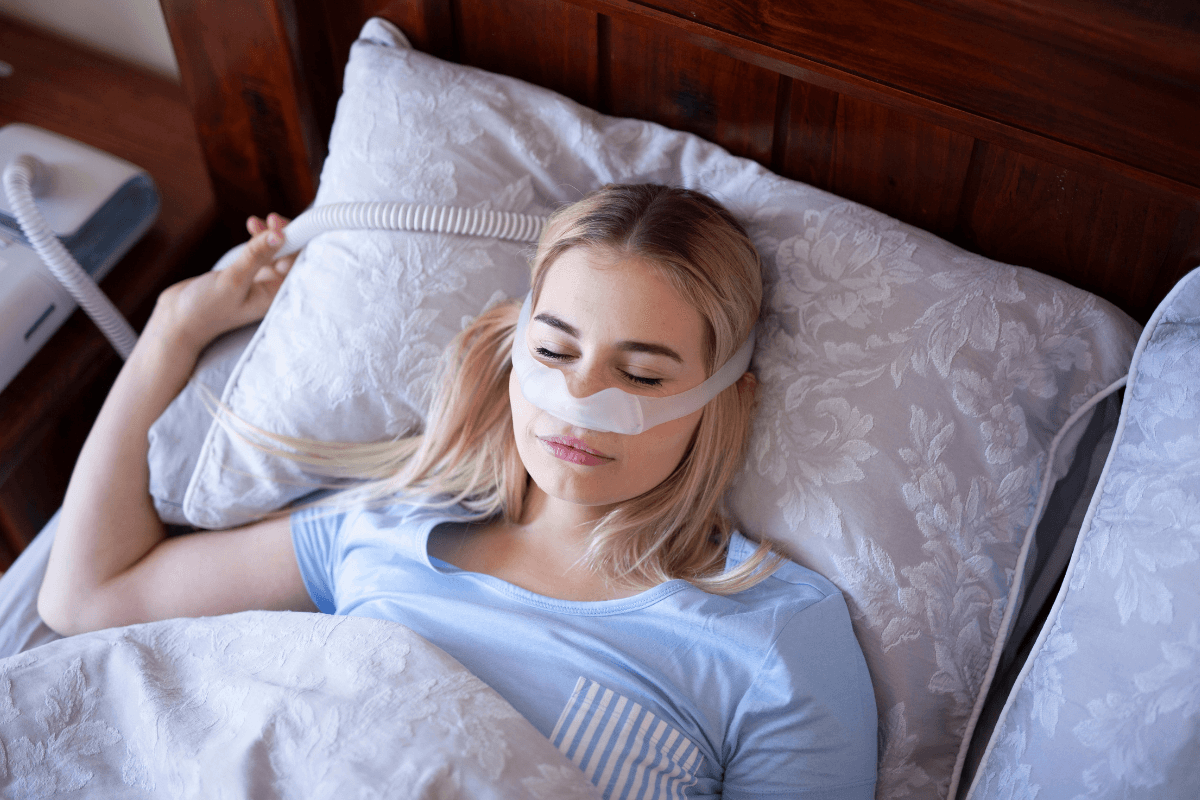Sleep apnea affects millions worldwide, silently disrupting breathing and rest. In fact, obstructive sleep apnea (OSA) is estimated to affect roughly 1 in 5 adults in moderate to severe forms, with many remaining undiagnosed. The health stakes are high: untreated OSA is linked to hypertension, cardiovascular disease, stroke, metabolic dysfunction, and cognitive decline.
In December 2024, a landmark shift occurred in OSA therapy. The FDA approves Zepbound for sleep apnea in adults with obesity. Until now, the primary treatments for sleep apnea have been devices (such as CPAP), surgery, or lifestyle modifications.
This article explores what this means for patients, how Zepbound works, clinical data, eligibility, administration, benefits, limitations, and practical steps for accessing the therapy.
Understanding Sleep Apnea and Its Challenges
Sleep apnea, particularly obstructive sleep apnea, occurs when the upper airway tissues collapse or narrow during sleep, interrupting airflow and causing drops in blood oxygen and arousals. These interruptions can happen dozens of times per hour, fragmenting deep sleep cycles and placing strain on the cardiovascular system.
Traditional sleep apnea treatment focuses on supporting airflow (e.g., CPAP, BiPAP machines), surgical approaches (such as uvulopalatopharyngoplasty and maxillomandibular advancement), oral appliances, weight loss, positional therapy, or hypoglossal nerve stimulation. These remain foundational, especially when structural or anatomical factors dominate.
What was missing until recently was a pharmacologic option specifically targeting the condition itself rather than just its consequences.
Is Zepbound Approved for Sleep Apnea?
Yes, Zepbound is officially approved to treat obstructive sleep apnea (OSA) in adults with obesity. This regulatory milestone marks the first time a medication has been authorized to target OSA through metabolic pathways rather than mechanical airway support.
By addressing excess weight and insulin resistance, two major drivers of airway obstruction, Zepbound offers a new treatment avenue that complements CPAP and other established therapies. Its approval represents a broader shift toward integrating metabolic management into sleep disorder care, offering patients more comprehensive and sustainable options for long-term relief.
What Is Zepbound and Why Does It Matter
Zepbound treatment involves using tirzepatide to manage obstructive sleep apnea (OSA) in adults with obesity. Tirzepatide is a dual agonist of the GLP-1 (glucagon-like peptide 1) and GIP (glucose-dependent insulinotropic polypeptide) receptors, previously approved for use in weight management.
The medication’s approval for treating and managing OSA signals a paradigm shift for eligible patients. Zepbound adds a biochemical tool targeting weight (a root contributor) and its downstream effects on airway collapse.
How Does Zepbound Work for Sleep Apnea?
Here’s a look at the mechanism and clinical evidence of using Zepbound for sleep apnea:
Mechanism Weight Loss and Systemic Effects:
- By enhancing satiety and slowing gastric emptying, tirzepatide promotes substantial weight loss over time.
- Reduced fat mass around the neck, tongue, and pharyngeal tissues may ease airway collapsibility.
- Beyond weight, tirzepatide lowers systemic inflammation markers (such as hsCRP) and may improve oxygenation and vascular health factors that contribute to the severity of OSA.
Clinical Evidence in Key Trials:
- Patients treated with tirzepatide experienced a mean reduction in Apnea-Hypopnea Index (AHI) of up to 63 percent, approximately 30 fewer apnea events per hour compared to the placebo.
- Improvements were observed not only in AHI but also in hypoxic burden, blood pressure, and patient-reported sleep quality.
- In some participants, the OSA resolved (that is, remission) under treatment.
- These effects were observed in patients using CPAP devices and those not using them, suggesting an additive benefit.
- Because obesity is a key risk factor for OSA, targeting it effectively can change the disease dynamics.
Who Is Eligible
Zepbound is indicated for adults with moderate to severe obstructive sleep apnea and obesity, that is, a BMI in the obesity range. The trials focused on obese populations because adiposity is a driver of airway obstruction.
Patients with non-obesity-related OSA (for example, an anatomically narrow airway despite a normal BMI) may derive less benefit.
Contraindications and Screening Considerations
Before starting Zepbound treatment for sleep apnea, patients should undergo a complete health evaluation to ensure the medication’s safety. Those with a personal or family history of medullary thyroid carcinoma (MTC) or multiple endocrine neoplasia type 2 (MEN 2) must avoid the drug, as these rare endocrine disorders carry a theoretical risk of thyroid tumors linked to GLP-1 class agents.
Individuals with a history of pancreatitis also require caution, since Zepbound may worsen pancreatic inflammation in susceptible patients. Healthcare providers should counsel patients to report any severe abdominal pain, nausea, or vomiting, which could indicate an adverse pancreatic reaction.
How Safe Is Tirzepatide for Sleep Apnea Patients?
Tirzepatide has safety data from its prior use in weight management. Common side effects include gastrointestinal symptoms (nausea, diarrhea), abdominal discomfort, and injection site reactions. It carries caution in patients with personal or family history of certain thyroid cancers. Long-term safety in the sleep apnea population is still under ongoing observation.
How to Get Zepbound for Sleep Apnea
Getting this medication for sleep apnea involves navigating the prescribing process and understanding insurance coverage options.
- Consult a sleep specialist or pulmonologist, ideally one who is experienced in OSA and obesity medicine.
- Undergo diagnostic sleep testing (for example, full polysomnography) to confirm moderate to severe OSA.
- Evaluate BMI, comorbidities, contraindications, and patient preferences.
- If eligible, the physician prescribes Zepbound with the indication for OSA (not just weight).
- Work with the payer or insurance to secure coverage (many plans are beginning to cover since FDA approval).
- Initiate treatment under supervision, combining lifestyle measures, a reduced-calorie diet, exercise, and continued use of CPAP or other OSA devices if prescribed.
As this is a newly approved indication, coverage policies may vary among insurers, regions, and formularies.
Benefits and Limitations
Like any medical treatment, Zepbound for sleep apnea offers significant advantages but also comes with certain challenges. Understanding both helps patients and physicians make informed choices about whether this therapy fits into a comprehensive sleep apnea management plan.
Advantages
- Adds a pharmacologic option to complement existing OSA therapy
- Potential for substantial weight reduction, which addresses a root cause
- Demonstrated reduction in AHI, improved oxygenation, and lower blood pressure
- May allow some patients to reduce dependence on devices
Limitations and Cautions
- It is not a standalone cure for all types of OSA; structural causes may persist.
- Benefits develop over weeks to months, rather than being immediate.
- Potential side effects: nausea, vomiting, abdominal discomfort, gastrointestinal symptoms, injection site reactions (consistent with GLP-1 agonists)
- Discontinuation might lead to the reversal of gains.
- Cost and insurance access may hinder uptake.
- Long-term safety and efficacy are still being closely monitored.
- Requires accompanying lifestyle changes (diet and exercise) to maximize benefit
Practical Advice for Patients
- Maintain rigorous follow-up with your sleep physician and weight management specialist.
- Continue using CPAP or other device therapy unless advised otherwise.
- Monitor side effects and report promptly.
- Be patient, weight loss-driven outcomes take time.
- Use mobile health tools, nutrition counseling, and sleep hygiene practices to support goals.
For those managing long-term treatment, cost and convenience are key. You can find affordable, high-quality prescription medications, including Zepbound, with convenience and reliable service.
Explore our Zepbound Product Page to learn more and easily place your order today.
Conclusion
The advent of Zepbound treatment for sleep apnea is a therapeutically exciting development. For the first time, there is an FDA-approved medication targeting moderate to severe obstructive sleep apnea in obese adults. By reducing weight and mitigating systemic contributors to airway collapse, Zepbound holds promise for transforming care for many patients who have struggled with devices alone.
However, Zepbound is not a magic bullet. Its effectiveness depends on patient selection, continued adherence, lifestyle modifications, and regular monitoring. As we gather more real-world data, the role of tirzepatide in treating sleep apnea may become further clarified. In the meantime, patients should work closely with sleep medicine specialists to explore whether this novel therapy is right for them.
Frequently Asked Questions (FAQs)
What is Zepbound treatment for sleep apnea, and why was it approved?
Zepbound treatment for sleep apnea refers to the use of tirzepatide specifically for treating obstructive sleep apnea in obese adults. It was approved by the FDA in December 2024 as the first prescription medication for moderate to severe OSA, based on trials showing meaningful reductions in apnea events and improved sleep outcomes.
How does Zepbound treatment for sleep apnea differ from existing treatments?
Traditional treatments for sleep apnea address mechanical airway support (for example, CPAP) or structural interventions (surgery). Zepbound works systemically through weight loss and metabolic effects to reduce the underlying forces that worsen airway collapsibility. It is intended to complement, not always replace, existing treatments.
Can everyone with sleep apnea use Zepbound?
No. It is indicated for obese adults with moderate to severe OSA. Patients with primarily anatomical causes or non obese OSA may derive less benefit. Additionally, contraindications (such as a history of thyroid cancer) and insurer policies may restrict eligibility.
How to get Zepbound treatment for sleep apnea in practice?
You start with a sleep study and evaluation of eligibility. Then, a physician prescribes Zepbound with the OSA indication. The patient works with insurance for coverage. Treatment should be combined with a balanced diet, regular exercise, and any applicable existing OSA therapies.


